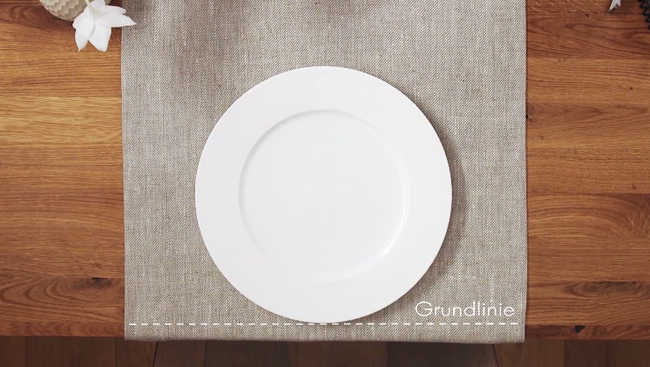
Properly arrange the cutlery and prepare the table.
Are you ready to impress your guests with a delicious 4-course meal? As your dishes slowly cook, it's natural to feel a bit unsure about setting the table. But don't worry, our instructions will guide you in properly arranging dishes, cutlery, and glasses. Not only will you showcase your amazing cooking skills, but you'll also create a warm and inviting atmosphere for a memorable dinner.

HOW DO I SET THE TABLE FOR A 4-COURSE MENU?
How do you arrange cutlery, napkins and glasses correctly? Find out more in our video here.
Prepare the table and arrange the silverware properly.

1. Ambience & Decoration
Enhancing the ambience of your dining experience can be achieved by incorporating a lovely table runner or coordinating placemats. It is recommended that guests are seated directly across from one another to facilitate effortless conversation. Furthermore, ensuring each guest has a comfortable 50-70 cm of personal space at the table will prevent any feelings of being crowded.

2. The baseline
Now you start with the charger plate. This should be placed in the middle, a thumb's width from the edge of the table. This is called the baseline. If you want your table to look extra festive, fold a napkin and place it in the middle of the plate.

3. The fork line
To properly set the table for the main course, position the dinner knife to the right of the plate along the baseline, with the cutting edge facing towards the left. Similarly, place the dinner fork to the left of the plate on the baseline. The fish knife should be placed on the baseline to the right of the menu knife. As for the fish fork, it should be positioned to the left of the dinner fork, ensuring that the tines are aligned with the hole in the fish fork. If you have opted for a different middle course, simply use a dinner knife and a dinner fork.

4. Cutlery for starters and salad
To correctly arrange the table for the main course, position the dinner knife to the right of the plate, along the baseline, with the sharp edge facing towards the left. Likewise, place the dinner fork to the left of the plate, also along the baseline. The fish knife should be placed on the right side of the plate, along the baseline, next to the menu knife. As for the fish fork, it should be positioned to the left of the dinner fork, making sure that the tines are aligned with the hole in the fish fork. If a different middle course is being served, simply use a dinner knife and dinner fork.

5. Lay out the cutlery for the dessert
The dessert cutlery is neatly arranged above the plate, and aligned with the edge of the table. The dessert spoon rests on top, angled towards the left, while the dessert fork lies below, pointing towards the right. This creates a distinct head line.

6. The straightening glass line
We will now begin the process of positioning the glasses. The chosen serving glass should complement the main course and be placed directly above the main course knife, at the same level as the dessert cutlery.

7. Position glasses correctly
To properly set the table, position a second wine glass and a water glass diagonally to the right of the main glass. Be mindful to arrange them in a diagonal line, following the glass line. While there is room for artistic expression in table decoration, it should still be appropriate for the occasion. Take care not to obstruct the other person's view with excessive decor.

EXCEPTIONS: PLACE CUTLERY FOR SPaghetti Dishes and for Left-Handed People
When serving spaghetti, it is customary to place the spoon on the left side of the plate and the fork on the right. This is due to the fact that spaghetti is typically eaten by twirling it on the spoon and using the fork in the right hand.
Do any of your guests happen to be left-handed? In this case, it may not be necessary to specifically rearrange the utensils for them. They are likely accustomed to finding their own comfortable way of eating. As you set the table, consider leaving more space to the left for your left-handed guests. This small gesture can promote harmony between both right- and left-handed individuals at the table.
Your account will be deleted!
Notify me when available
This field is required






